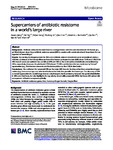Supercarriers of antibiotic resistome in a world’s large river
Date
2022-12Author
Subject
Metadata
Show full item recordAbstract
<jats:title>Abstract</jats:title><jats:sec> <jats:title>Background</jats:title> <jats:p>Antibiotic resistome has been found to strongly interact with the core microbiota in the human gut, yet little is known about how antibiotic resistance genes (ARGs) correlate with certain microbes in large rivers that are regarded as “terrestrial gut.”</jats:p> </jats:sec><jats:sec> <jats:title>Results</jats:title> <jats:p>By creating the integral pattern for ARGs and antibiotic-resistant microbes in water and sediment along a 4300-km continuum of the Yangtze River, we found that human pathogen bacteria (HPB) share 13.4% and 5.9% of the ARG hosts in water and sediment but contribute 64% and 46% to the total number of planktonic and sedimentary ARGs, respectively. Moreover, the planktonic HPB harbored 79 ARG combinations that are dominated by “natural” supercarriers (e.g., <jats:italic>Rheinheimera texasensis</jats:italic> and <jats:italic>Noviherbaspirillum</jats:italic> sp. Root189) in river basins.</jats:p> </jats:sec><jats:sec> <jats:title>Conclusions</jats:title> <jats:p>We confirmed that terrestrial HPB are the major ARG hosts in the river, rather than conventional supercarriers (e.g., <jats:italic>Enterococcus</jats:italic> spp. and other fecal indicator bacteria) that prevail in the human gut. The discovery of HPB as natural supercarriers in a world’s large river not only interprets the inconsistency between the spatial dissimilarities in ARGs and their hosts, but also highlights the top priority of controlling terrestrial HPB in the future ARG-related risk management of riverine ecosystems globally.</jats:p> </jats:sec>
Collections
Publisher
Place of Publication
Journal
Volume
Issue
Pagination
Author URL
Number
Recommended, similar items
The following license files are associated with this item:


